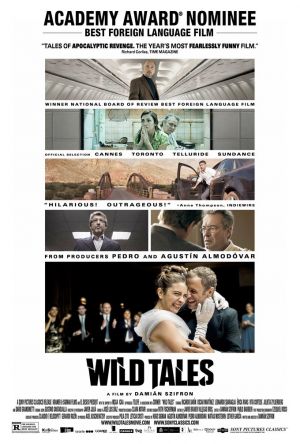
By Duncan Sinclair
An anthology is more complex than a single story, as an ecosystem is more complex than a single species. (*This review contains mild spoilers.)
The opening credits to Damian Szifron’s Wild Tales play over images of wild animals, almost blatantly spelling out his worldview in the first ten minutes of the film. Billed as a black comedy featuring six stories of revenge, the movie begins with airplane passengers bonding over their mutual dislike of a man only to find out he is their suicidal pilot and they are all trapped onboard. The frame freezes on the nose of the plane seconds before it crashes and the wildlife montage begins to roll accompanied by Gustavo Santaoalla’s western-inspired score.
It’s a blunt, easy, even immature attitude: people are essentially animals and so let’s sit back and watch the fun. This first story is easily the deadliest of the six, yet it is so unrealistic and unexpected that the audience is jolted into paying attention without giving it much thought. From there the film offers no indication that it will give you a thesis on revenge but rather more twisted, ironic situations to keep you emotionally drained. The second story introduces the idea of prison and retribution towards the corrupt. But since the revenge is carried out by a secondary character we don’t feel the catharsis of justice being delivered so much as a satisfactory end to a story where everything works out as we wanted it to. The third story, though much more down-to-earth than the first, also contains exaggerated acts of violence and ends on a punchline.
It’s in the fourth story that the film shifts perspective. After being bankrupted and humiliated by his wife, boss, and government, a sympathetic demolitions worker blows up the towed vehicle lot that instigated his downward spiral. This is an expected outcome at this point; several people tell him that he cannot be happy always raging against the world, though we know the film isn’t going to accept that argument. But once he gets his (non-deadly) revenge the public overwhelmingly supports his actions and vindicates his struggle (and vicariously, our own). It’s the ending we wanted, but did not expect. It recalls the ending to Taxi Driver, where Travis Bickle’s unchecked aggression it aimed at the “right people”, and so he gets labeled a hero rather than a villain. The woman’s words from the second tale “Everyone wants these guys to pay but no one is willing to lift a finger” ring a little louder. The film has presented its version of the best possible outcome to a man violently resisting life. It could easily end on this cheerful note.
But an anthology is more complex than a single story.
The fifth story contains one act of vengeance, and ends mere seconds before it occurs. Here, revenge does not bring catharsis, humor, or satisfaction. There is only gloom and sorrow. By the time the sixth tale comes about, having been run through the gamut of emotions, you don’t entirely know what to think about the film’s running motif. And by how complicated things get as more characters and digressions are added, you get the feeling Szifron doesn’t either. He doesn’t end with a grand statement on the nature of man, but he does give us an amusing, passionate sex act that at least suggests that we’re better off focusing our carnal impulses on things other than violence.
Reflecting on the tales in the context of the whole picture complicates them. Easy as it is to feel morally superior to every character, the relative nature of each scenario elicits different reactions. Who is to blame for each escalation of conflict? Who among the victims deserved their fate? How far is too far before you cross a line and become the villain? Even the animal photos seem deceptively complex in retrospect, for an ecosystem is more complex than a single species. The slideshow begins on the image of the symbolically brash bald eagle followed by the symbolically fearsome Great White. An image of a harmless sheep is shown leering menacingly from the brush, while a carnivorous crocodile is shown smiling at the camera. Human behavior can be beastly, but we are able to step back and see that there are layers to life and we have more options than we think. And we can use empathy and reasoning to judge situations for ourselves.
In fact, it is our ability to do so that makes us separate from the animals.